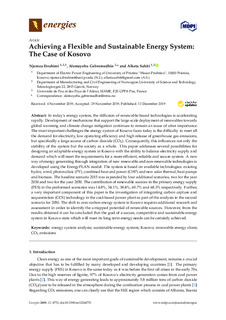| dc.contributor.author | Ibrahimi, Njomza | |
| dc.contributor.author | Gebremedhin, Alemayehu | |
| dc.contributor.author | Sahiti, Alketa | |
| dc.date.accessioned | 2020-01-15T07:24:18Z | |
| dc.date.available | 2020-01-15T07:24:18Z | |
| dc.date.created | 2019-12-04T09:24:41Z | |
| dc.date.issued | 2019 | |
| dc.identifier.citation | Energies. 2019, 12 (24), . | nb_NO |
| dc.identifier.issn | 1996-1073 | |
| dc.identifier.uri | http://hdl.handle.net/11250/2636300 | |
| dc.description.abstract | In today’s energy system, the diffusion of renewable-based technologies is accelerating rapidly. Development of mechanisms that support the large-scale deployment of renewables towards global warming and climate change mitigation continues to remain an issue of utter importance. The most important challenges the energy system of Kosovo faces today is the difficulty to meet all the demand for electricity, low operating efficiency and high release of greenhouse gas emissions, but specifically a large source of carbon dioxide (CO2). Consequently, this influences not only the stability of the system but the society as a whole. This paper addresses several possibilities for designing an adaptable energy system in Kosovo with the ability to balance electricity supply and demand which will meet the requirements for a more efficient, reliable and secure system. A new way of energy generating through integration of new renewable and non-renewable technologies is developed using the EnergyPLAN model. The system is based on available technologies: existing hydro, wind, photovoltaic (PV), combined heat and power (CHP) and new solar thermal, heat pumps and biomass. The baseline scenario 2015 was expanded by four additional scenarios, two for the year 2030 and two for the year 2050. The contribution of renewable sources in the primary energy supply (PES) in the performed scenarios was 14.8%, 34.1%, 38.4%, 69.7% and 68.3% respectively. Further, a very important component of this paper is the investigation of integrating carbon capture and sequestration (CCS) technology in the coal-based power plant as part of the analysis in the second scenario for 2050. The shift to zero-carbon energy system in Kosovo requires additional research and assessment in order to identify the untapped potential of renewable sources. However, from the results obtained it can be concluded that the goal of a secure, competitive and sustainable energy system in Kosovo state which will meet its long-term energy needs can be certainly achieved. | nb_NO |
| dc.language.iso | eng | nb_NO |
| dc.publisher | MDPI | nb_NO |
| dc.rights | Navngivelse 4.0 Internasjonal | * |
| dc.rights.uri | http://creativecommons.org/licenses/by/4.0/deed.no | * |
| dc.title | Achieving a Flexible and Sustainable Energy System: The Case of Kosovo | nb_NO |
| dc.type | Journal article | nb_NO |
| dc.type | Peer reviewed | nb_NO |
| dc.description.version | publishedVersion | nb_NO |
| dc.source.pagenumber | 22 | nb_NO |
| dc.source.volume | 12 | nb_NO |
| dc.source.journal | Energies | nb_NO |
| dc.source.issue | 24 | nb_NO |
| dc.identifier.doi | 10.3390/en12244753 | |
| dc.identifier.cristin | 1756369 | |
| dc.description.localcode | ©2019 by the authors. Licensee MDPI, Basel, Switzerland. This article is an open accessarticle distributed under the terms and conditions of the Creative Commons Attribution(CC BY) license (http://creativecommons.org/licenses/by/4.0/). | nb_NO |
| cristin.unitcode | 194,64,94,0 | |
| cristin.unitname | Institutt for vareproduksjon og byggteknikk | |
| cristin.ispublished | true | |
| cristin.fulltext | postprint | |
| cristin.fulltext | original | |
| cristin.qualitycode | 1 | |

